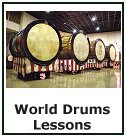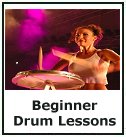Conga Drums
Contents

Conga drums come in a wide array of shapes, sizes and colors.
The vibrant colors of the conga attempt to capture the essence and flavor of the culture they represent.
These Afro-Cuban drums are popular in many styles of music, most notably rumba and Latin genres such as salsa and merengue.
It can often be heard in much of today’s reggae and is quickly becoming popular in more mainstream genres.
Conga Tones
There are many different sounds that you can get out of these drums. Using a few basic hitting techniques and pitch bending, you can create your own unique conga sound.
Open Tone: Achieved by hitting the conga on the head near the rim with four fingers.
Muffled Tone: Similar to the Open Tone, but the fingers remain on the head which muffles the sound.
Bass Tone: Achieved by hitting the conga in the middle with the whole of the palm.

Slap Tone: As the name implies, you slap the head in a whip-like motion which produces a popping sound.
Touch Tone: Just touching the drums head with your fingers will produce a light, yet audible tone which can be combined with palm hits to produce a roll.
Glissando (Moose Call): This sound is produced by rubbing a finger across the conga head. The finger may be moistened to help produce this sound.

Pitch Bends: You can change the pitch of the drums by applying pressure to the head with either your fingers, hand or elbow.
Although these drums are traditionally played with the hands, some artists use sticks with special tips or mallets.
Conga Drum Lessons
I haven’t finished editing my conga lesson videos yet, but while I’m working on it, you might want to check out these drum books and DVD’s that are available from my affiliates.
Learn more about world drums and find more drum lessons on the pages below:








New! Comments
Leave your comments below.